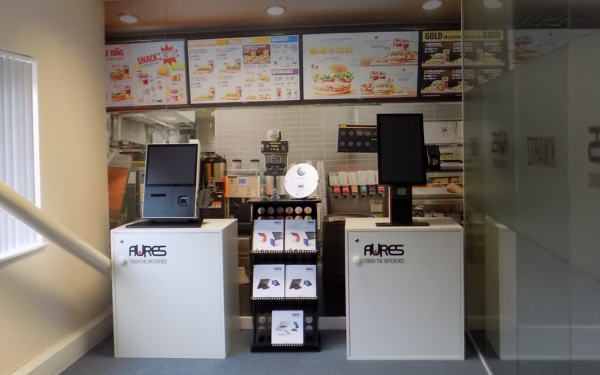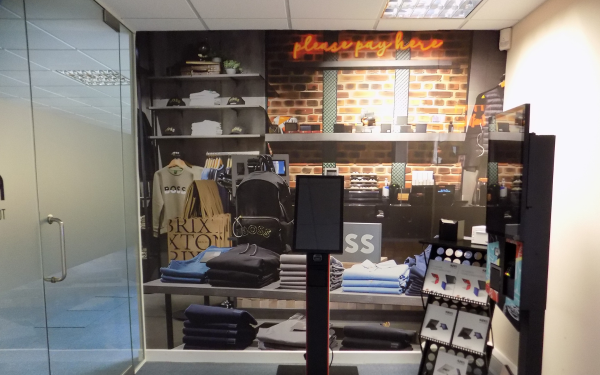Kiosks are nothing if not flexible. Adaptability has been key to self-service technology rapidly becoming a staple across customer-facing industries, with no indication that the boom in adoption will slow down any time soon. Indeed, some estimates forecast the global kiosk market will almost triple in size in the next decade.
What is particularly fascinating about the kiosk phenomenon is the way that different industries leverage the technology in unique ways to enhance customer experience, streamline operations, and boost efficiency. You can learn a lot about the potential of self-service systems by comparing these differences, and understanding how the technology is able to adapt to meet the various demands.
So in this article, we thought we’d take a closer look at the way self-service kiosks are being used across five sectors – general retail (including grocery), trade counters, restaurants, hotels and accommodation, and leisure and entertainment.
Retail
In retail, self-service kiosks have revolutionised the checkout process. The ability to quickly scan and pay for their items independently and reduce wait times has proved popular with shoppers and retailers alike. Kiosks are most visible in the self-checkout lanes of supermarkets, where the number of units has increased by 50% in the past five years. Moreover, despite concerns over glitchy experiences and security at grocery self-checkout, 97% of shoppers say they are happy to keep using self-service options in supermarkets, with 51% saying they want to see more kiosks across other retail locations.
Beyond checkout, self-service kiosks are used in retail for product information, returns, and even order placement for online purchases. Fashion retailers, for example, demonstrate the versatility of kiosks by deploying them as virtual fitting rooms where shoppers can ‘try on’ an item via a camera, or for providing personalised styling recommendations.
Trade Counter
As a sub-sector of the retail industry serving professionals in construction, engineering, maintenance and more, trade counters have unique needs compared to B2C retail sectors (although many trade counters are also open to the public these days), and are increasingly turning to kiosks to help meet them. Trade sales rely on providing detailed product information and comparisons across lots of SKUs. Kiosks give customers the freedom to browse catalogues and look up information without having to wait to speak to an agent.
On top of this, kiosks can also be used for stock availability checks, order placement, customer account management, invoicing, and payment processing. The separation of product search and ordering from fulfilment also helps to reduce queues at point of sale.
Restaurants
Up there with supermarket self-checkout, ordering stations in quick-service restaurants continue to offer the most common day-to-day kiosk experience. Major chains like McDonalds, Subway and Burger King were early pioneers of kiosk technology going way back to the noughties, and quickly discovered the benefits of giving customers more ‘dwell time’ over their orders.
In fact, in the QSR sector, separating ordering from service with kiosks has achieved an almost alchemical double benefit. Allowing customers to build their orders and explore menu options in their own time boosts average order value, while also reducing average wait times and increasing throughput.
It’s no surprise, therefore, that self-ordering kiosks have all but taken over the QSR experience, with global installations soaring by 43% in just two years. The fine-dining sector is also following suit, with establishments adopting kiosks for table reservations (including providing information about availability and wait times), menu browsing, and order placement.
Accommodation
In the hotel sector, deployment of kiosks for self-check-in and check-out is on the rise, providing a 24/7 alternative to traditional front desk services. Not only does this give guests the freedom to check in and out when they want, but reception kiosks also provide a useful means of accessing information about hotel amenities and local attractions. Some hotels also use kiosks for concierge services, allowing guests to book tours, spa appointments, or transportation, while the use of in-room ‘mini kiosks’ is also on the rise for things like room service. According to one report from Statista, almost three-quarters of hotel guests said they would be more likely to stay at a hotel that offered self-service facilities.
Leisure and Entertainment
Kiosks have also become integral to the leisure and entertainment industry. Theme parks and amusement parks use them for ticket purchasing, ride reservations, and merchandise sales. Cinemas similarly deploy kiosks for ticket buying, but also for things like concessions orders and seat selection. Additionally, these kiosks can provide information about showtimes, movie trailers, and promotions.
While the core function of self-service kiosks is to provide convenience and efficiency, the way that this is realised across different sectors is testament to the versatility of the technology. As self-service technology continues to evolve, we can expect to see even more innovative applications of kiosks across industries, further transforming customer experiences and business operations.
To view the AURES UK full Self-Service Kiosk range please click here.





